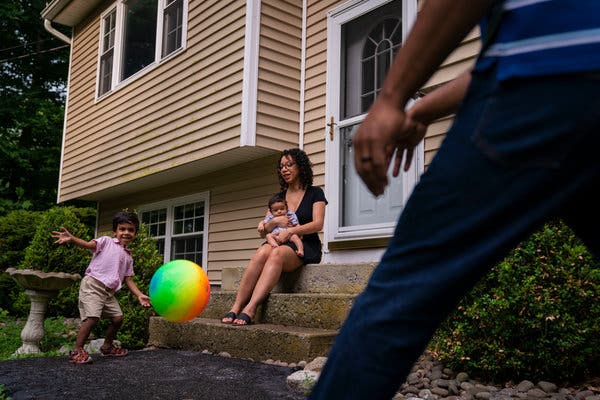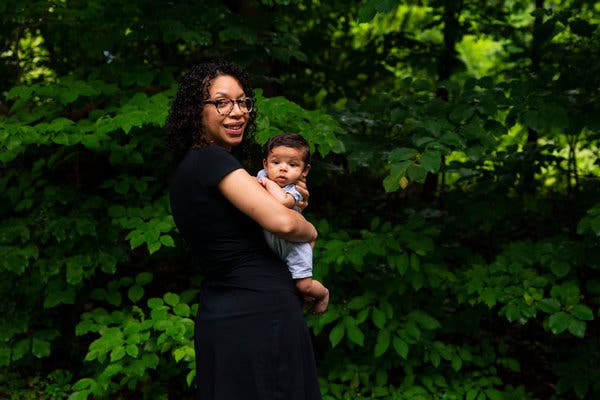
Advertisement
With coronavirus concerns, stay-at-home orders, financial instability and mounting civil unrest, it is no surprise that mothers are experiencing intensified anger.

By Minna Dubin
After I wrote a personal essay on mom rage in 2019, strangers on Twitter declared me an unfit mother. But I expected Twitter-hate. What I did not expect were the many emails I received from mothers around the world, saying they too struggle with mom rage and my story made them feel less alone.
After the initial flood of emails, a trickle continued over the next six months. Then Covid-19 happened, and with it, stay-at-home orders. My inbox began lighting up again, illuminating a direct correlation between mom rage and sheltering in place.
“Mom rage” is the colloquial term for the unrestrained anger many women experience during pregnancy, postpartum and beyond.
It is a popular topic these days in a support group for working moms at The Motherhood Center, a clinical treatment facility in Manhattan that offers services for pregnant and postpartum women. Paige Bellenbaum, a group facilitator and the center’s founding director, said, “Mom rage is something we talk about all the time. Social isolation, lack of support, managing high levels of anxiety and stress — this is the new normal of being a mother, and during the pandemic in particular.”
Anger and rage are waving red flags hinting at feelings below the surface. Mothers who experience rage may be feeling alone, unheard, and unsupported, Bellenbaum said. “But it’s so much more powerful to feel angry and rageful than to touch the vulnerability of what lives behind it.”
Between stay-at-home orders, Covid-19 health concerns, financial instability (or fear of it), and police violence against Black people, it is no surprise that mothers are experiencing intensified rage above the surface, and feelings of grief, fear, and loneliness below.
“We’re asking all parents, but it’s especially moms on the front lines, to try to do 24/7 child care without a break at the same time that they’re trying to often hold down a job,” said Laura Markham, Ph.D., a clinical psychologist, parenting coach and author of “Peaceful Parent, Happy Kids: How to Stop Yelling and Start Connecting.” “So, is there more mom rage?” she asked. “How could there not be?”
Mom rage expresses itself in different ways. Anya Persaud, who has a 3-year-old and a newborn and lives in Beacon, N.Y., could pinpoint her fury: “Raising my voice and walking hard are signs I’m heading from frustration to rage.”

Virginia Duan, who homeschools her four children, ages 3, 6, 8 and 10, in the San Francisco Bay Area, said: “It feels as if I am going to physically explode, like having an out-of-body experience where I cannot seem to control the litany of invectives flying from my mouth.”
Molly Caro May, who lives in Bozeman, Mont., and is the author of “Body Full of Stars: Female Rage and My Passage into Motherhood,” said of her rage, “I never hurt anyone, but I was out in the forest throwing rocks at trees.”
Moms aren’t supposed to yell and stomp and throw rocks, and we aren’t supposed to share our rage publicly. I have wondered if I’ve been able to write openly about mom rage without much reproach because it has become so commonplace in our lexicon, or if it is because I am white.
Nefertiti Austin, the author of “Motherhood So White: A Memoir of Race, Gender, and Parenting in America,” wasn’t familiar with the term “mom rage” but acknowledged that the intense anger is somewhat universal for moms. Of Black mothers, Austin said: “It’s tricky for us, because we are already saddled with ‘angry Black woman.’ I definitely don’t want to be described as having mom rage, because it’s not going to play the same if I say I have it, than if a white mom says she has it.”
Austin added that because of racist stereotypes, Black mothers are under more pressure to appear perfect. With police violence against Black people, Austin said, Black mothers may have their “children on a tighter leash than white parents.”
“The whole ‘kids will be kids’ thing? We know that that’s not true when it comes to our kids. There isn’t a lot of grace for Black children,” Austin said.
That fear and perfectionism can only add fuel to the mom-rage fire.
Since viewing the video of George Floyd’s death, Persuad said her mood and sleep have suffered. “I’ve had overwhelming anxiety and feelings of hopelessness and helplessness.”
Duan said one of the factors affecting her mom rage is “the trauma of being Asian-American during the pandemic,” after some, including President Trump, have blamed China for the coronavirus outbreak. The attack has led to a surge in xenophobia against Asian-Americans.
It’s been a few months since the pandemic began and several weeks since protests against police violence filled our neighborhoods. All the while, mothers continue to work multiple jobs at once (teacher and mom at a minimum), and they’re exhausted. May said she vacillates between “this week, we’re going to study cities of the United States” and “actually, we’re just going to be outside playing with sticks.”
Like May, Duan concedes her bandwidth has been lower since Covid-19. “I think it goes hand-in-hand with my resignation,” she said. “I’m fine with the kids just messing around and occasionally learning.”
Persaud is having similar throw-up-her-hands moments these days. “Where before I might have raised my voice, now I give in,” she said. She will allow her son to skip a nap or eat with the television on. “Surely, we can’t yell and scream every day, right?”
This “laissez faire” parenting style seems more than warranted during this strange, stuck-at-home period. But how can mothers fill up their tanks above empty? Is self-care even possible for mothers during the coronavirus era?
May described her self-care during the pandemic as “feast or famine.” “Some weeks, I’m on it,” she said. “I exercise, feed myself beautiful food, get some quiet time, and I feel really good. Other weeks I’m literally eating butter on bread in the corner of my kitchen eight times a day. It can feel like I just need to get my basic needs met and everyone is in the way of that.”
When I asked Persaud how she makes time for herself, she answered unequivocally, “Showers!” Whitney Sandoval, who lives in Wichita, Kan., with her 5- and 3-year-olds, will drive to pick up her groceries and then hang out in her car in the parking lot. “I listen to music or a podcast, read or just sit in silence. It’s the closest I can get to being alone.”
Eating properly, exercising, showering and getting a little alone time sound like they belong in the “basic health requirements” category as opposed to “self-care for mothers.”
Even if those bare minimum self-care needs are met, mom rage doesn’t just disappear. Rage has something to say and, according to Dr. Markham, “Rage doesn’t dissipate until it feels heard.”
Ruth King, an educator, life coach, meditation teacher and the author of many books, including “Healing Rage: Women Making Inner Peace Possible” and “Mindful of Race: Transforming Racism from the Inside Out,” said: “Rage sits at the crossroads of personal transformation. Rage is not to be understood as a useless emotion, empty of knowledge. Rather, rage is fierce clarity and untapped fuel — when we push rage away, we can’t learn from it.”
Unfortunately, many mothers are doing just that. It is a challenge to find mothers who will talk on the record for this article. One mom eagerly emailed me about her rage, but then declined being quoted, saying, “You know, mom shame.”
Bellenbaum of The Motherhood Center said, “There’s so much guilt that we feel toward ourselves, and a kind of inner-disappointment that we have these types of feelings at this intensity, especially toward our children.”
It can be challenging for partners living with those who have mom rage to be able to offer compassion and support, especially during the pandemic, when the emotional bandwidth of all parents is stretched thin.
In support groups at The Motherhood Center, Bellenbaum has seen mothers find the nonjudgmental witnesses they need in each other. She said, “When we connect with other women who are having the same feelings, that sense of community creates an initial and immediate relief.”
I have experienced this relief myself. What the mothers who write to me about their mom rage don’t know is that their emails help me feel less alone, too. Since the pandemic began, people have been clapping, singing and howling into the night at a certain hour. Some clap to thank essential workers. Others howl in grief or just to relieve stress. Maybe it’s time for mothers to take to the windows and bellow out a collective earsplitting roar.